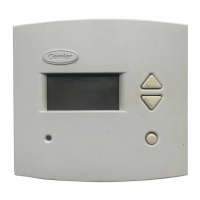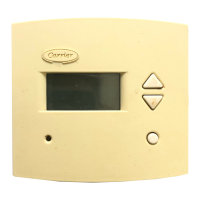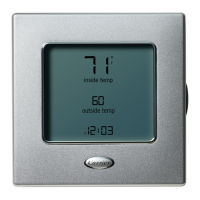How to fix a Carrier 33CS with no display?
- CCurtis TrujilloSep 2, 2025
If the display on your Carrier Thermostat is not illuminated, check for 24 vac at the R terminal connection. Terminal R must be connected for proper thermostat operation.









How to fix a Carrier 33CS with no display?
If the display on your Carrier Thermostat is not illuminated, check for 24 vac at the R terminal connection. Terminal R must be connected for proper thermostat operation.
What to do if both heating and cooling are energized when calling for cooling on Carrier Thermostat?
If both heating and cooling are energized when calling for cooling, the thermostat is likely configured for a heat pump. Configure the thermostat for non-heat pump operation (Table 2, Step 3).
How to fix Carrier Thermostat when heating equipment tries repeatedly to turn on?
If, when using 4 wires (R, G, W, Y), the heating equipment tries repeatedly to turn on but cannot with your Carrier Thermostat, it means there isn't enough power available. To fix this, connect a 270-ohm, 10-watt power resistor at the air-conditioning equipment between terminals Y and C (non-heat pump applications only).
What to do if cooling will not energize on Carrier Thermostat?
If your Carrier Thermostat's cooling isn't working, first select COOL mode and decrease the cooling set point to 10 degrees below room temperature. Check for 24 vac at the Y1 terminal with a load connected. If the voltage is present, the thermostat is working correctly, and the issue lies with the wiring or equipment. If 24 vac is not present, replace the thermostat. Also, check the Compressor Cycle per Hour Limit, as cooling may be locked out.
What to do if 'Service Filter' is displayed on Carrier Thermostat?
If your Carrier Thermostat displays 'Service Filter', you should reset the Service Filter feature. This will reset the blower operation timer to 0 hours.
What to do if resistor L3 is burned out on Carrier 33CS Thermostat?
If the resistor labeled “L3” on your Carrier Thermostat is burned out and brown, and the thermostat won't work, it means the thermostat has been wired incorrectly and the circuit board is burned out. You must replace the thermostat.
How to troubleshoot a Carrier 33CS with a blank LCD display?
To troubleshoot a Carrier Thermostat with a blank LCD display, check for 24 vac between R and C at the terminal connections. Both R and C must be connected for proper thermostat operation.
Why does my Carrier 33CS Thermostat display a large set point instead of the room temperature?
If your Carrier Thermostat displays a large set point instead of the room temperature, it means the thermostat is set to a single set point instead of a dual set point. This setting can be adjusted in Advanced Setup Step 4.
How to fix a Carrier Thermostat display that only shows the clock?
If your Carrier Thermostat display only shows the clock, this setting is configured in Advanced Setup Step 3. To resolve this, change the Display Blanking configuration to Off.
Why is my Carrier Thermostat displaying '--'?
If your Carrier Thermostat is displaying '--', it indicates that the temperature sensor reading is out of range. Check the sensor for damage and inspect the sensor wiring. Try cycling power to the thermostat. If the display doesn't clear, replace the thermostat.
| Type | Non-programmable |
|---|---|
| Power Source | 24 VAC |
| Stages | 1 Heat/1 Cool |
| Voltage | 24 VAC |
| Accuracy | ±1°F |
| Display | Digital |
| Compatibility | Single Stage Systems |
| Temperature Range | 45°F to 90°F |
| Programmability | No |
Guidance on selecting the optimal location for mounting the thermostat.
Instructions for configuring the thermostat's DIP switches.
Detailed steps for physically installing the thermostat unit.
Using multiple sensors for accurate average temperature readings.
Configuring advanced thermostat settings and options.
Diagrams illustrating wiring connections for various models.
Diagram showing the layout of components on the thermostat circuit board.
System settings like F/C, fan modes, and lockout features.
Procedures for verifying thermostat functionality and settings.
Setting up daily heating and cooling schedules.
Temporarily changing schedules and post-installation tasks.
Controls and timers for hold, fan, mode, and protection.
Initial checks and troubleshooting error messages.
Resolving problems related to the thermostat's LCD display.
Diagnosing why heating or cooling systems are not activating.












